From inside (document excerpt):
Quick Installation Guide Quick Installation Guide Timer Installation Indoor Model Cabinet Installation Cabinet Installation page 2 Connecting the Valves . page 2 Connecting a Pump Start Relay page 3 Connecting the Plug-In Transformer page 3 Outdoor Model Cabinet Installation Preparing the Cabinet for Installation page 4 Installing the Cabinet . page 4 Connecting the Valves . page 5 Connecting a Pump Start Relay page 6 Connecting the Power Source .
page 6 Connecting a Rain Sensor page 6 ECXTRA Scheduling Advisor Installation . page 7 ECXTRA Scheduling Advisor Programming page 8 Questions? Call Toro Customer Support @ 800-895-4922 Thank you for purchasing ECXTRA, one of the most advance landscape controller today. Timer Installation Note: The ECXTRA indoor timer is not weather resistant and must be installed indoors or in a protected area. Indoor Model Cabinet Installation 1. Select a location for the timer within 4′ of an electrical outlet to enable the transformer cord to easily reach. Make sure the outlet is not controlled by a light switch. 2. Remove the mounting bracket attached to the back of the timer housing by pulling the lower edge of the bracket away and downward from the timer housing. 3. Place the mounting bracket against the wall aligning the top edge at about eye level. Drive three 1 ” wood screws into the wall through the three holes provided in the bracket. Note: If you are installing the bracket on drywall or masonry, install screw anchors to prevent screws from loosening. 4. Optional – Insert 3/4 ” PVC conduit for valve wiring into bracket sleeve. 5. Align the slotted openings on the back of timer housing with the mounting bracket tabs. Slide the timer downward to engage the tabs. Note: After installation, store the Quick Reference Guide and the Watering Schedule Form in the pocket behind the timer. Connecting the Valves 1. Route the valve control wires between the valves and the timer. Note: The snap-in wire connectors accept 14 to 18 gauge wire. Using 18-gauge, multi-strand, direct-burial irrigation cable is recommended. Choose a cable that has at least one more wire conductor than the number of valves to be connected. 2. Attach the white color-coded wire to either one of the wires from each valve solenoid. This is called the valve common wire. 3. Attach an individual color-coded wire to the remaining wire from each valve solenoid. Make a note of the wire color used for each valve and the watering zone it controls. You will need to have 2 this information when connecting the valve wires to the timer. CAUTION: Use Toro Waterproof Wire Connectors (Model # 53687) or grease caps on all exposed wire splice connections to prevent corrosion, connection failure and possible short circuit. 4. Route the wire cable into the timer through the large opening in the base of the housing or through PVC conduit (if it is installed). Strip insulation back 1/2 ” from all cable wires. Note: The zone module has snap-in wire terminals. To attach wires, simply raise the lever, insert the stripped wire, and press the lever down to secure. 5. Secure the valve common wire to the terminal labeled COM. Connect the individual zone valve wires to the appropriate zone module terminals. Connect the master valve wire (if applicable) to the terminal labeled PUMP/MV. Note: Connecting a master valve or pump start relay is optional and may not be required in your sprinkler system. Connecting a Pump Start Relay CAUTION: To prevent timer damage, ensure the 24 V ac pump relay current draw does not exceed 0.30 Amps. Do not connect the timer directly to the pump starter. 1. Route a wire pair from the pump relay into the timer housing. 2. Connect one wire to the terminal labeled COM. Connect the remaining wire to the terminal labeled PUMP/MV. CAUTION: To prevent pump damage due to “dead-heading, ” connect a jumper wire from any unused zone terminal to a zone terminal with a valve connected. Connecting the Plug-In Transformer CAUTION: Do not plug the transformer into an electrical outlet until all of the wiring procedures have been completed. 1. Route the cord from the transformer through the small opening provided in the base of the housing. 3 2. Connect one transformer cable wire to each terminal labeled 24 VAC. The wires can be connected to either terminal. Note: The display will begin flashing 12:00 AM. Press any button to stop the display from flashing. (G) – 1/2 ” (plugged) for optional Toro remote control cable. 4. If planning to install the optional Toro components, remove the plugs as necessary. Outdoor Model Cabinet Installation Preparing the Cabinet for Installation 1. Remove the lower housing cover by pulling outward on the handle. 2. Remove two phillips screws from the transformer access cover. Pull the cover outward from the bottom to remove. 3. Three lower mounting holes are provided. The center hole is open and the outer holes are plugged. If you intend to use the outer holes for installation, carefully drill through the plugs with a 3/16 ” drill bit. Four wiring access holes are provided in the cabinet base as follows: (D) – 1/2 ” for power and equipment ground wires. (E) – 1/2 ” (plugged) for optional Toro Rain Sensor wires. (F) – 3/4 ” for sprinkler valve wires. Installing the Cabinet 1. For safe, reliable operation, select an installation site which will provide the following conditions: · Protection from irrigation spray, exposure to direct sun during the hottest hours, wind and snow. · Access to a grounded power source which is not controlled by a light switch or utilized by a high current load appliance, such as a refrigerator or air conditioner. · Access to the sprinkler control valve wiring and optional accessory wiring. 2. Drive a wood screw (provided) into the wall at eye level. Leave the screw extended approximately 1/4 ” from the wall. Note: If you are installing the timer on drywall or masonry, install screw anchors to prevent screws from loosening. 4 3. Hang the cabinet on the screw using the keyhole slot on the back panel. Make sure the cabinet slides down securely on the screw. 4. Install the lower mounting screw(s) and tighten securely. Note: Conduit and adapters are not provided. Install conduit as required by local electrical codes. 5. Install 1/2 ” conduit for power/equipment ground wires and 3/4 ” conduit for valve wires. Note: After installation, store the User’s Guide and Quick Reference Guide on the hook located on the inside of the door. Connecting the Valves 1. Route the valve wires or wire cable from the valves, into the timer cabinet. Note: The snap-in wire connectors accept 14 to 18 gauge wire. Using 18-gauge, multi-strand, direct-burial irrigation cable is recommended. Choose a cable that has at least one more wire conductor than the number of valves to be connected. 2. Attach the white color-coded wire to either one of the wires from each valve solenoid. This is called the valve common wire. 3. Attach an individual color-coded wire to the remaining wire from each valve solenoid. Make a note of the wire color used for each valve and the watering zone it controls. You will need to have this information when connecting the valve wires to the timer. CAUTION: Use Toro Waterproof Wire Connectors (Model # 53687) or grease caps on all exposed wire splice connections to prevent corrosion, connection failure and possible short circuit. 4. Route the wire cable into the timer through the large opening in the base of the housing or through PVC conduit (if it is installed). Strip insulation back 1/2 ” from all cable wires. Note: The zone module has snap-in wire terminals. To attach wires, simply raise the lever, insert the stripped wire, and press the lever down to secure. 5. Secure the valve common wire to the terminal labeled COM. Connect the individual zone valve wires to the appropriate zone module terminals. Connect the master valve wire (if applicable) to the terminal labeled PUMP/MV. 5 Note: Connecting a master valve or pump start relay is optional and may not be required in your sprinkler system. Connecting the Power Source 1. Route the power and equipment ground wires from the power source, through the conduit and into the timer transformer compartment. Note: The timer terminal block accepts wire size up to 14 gauge. 2. Remove 3/8 ” insulation from the wire ends. 3. Using a small flat blade screwdriver, secure the wires as shown to the terminal block as follows: Line or Line 1 (L1) to L, Neutral or Line 2 (L2) to N and Equipment Ground to. 4. Install and secure the transformer compartment cover. 5. Apply power to the timer. Note: The display will begin flashing 12:00 AM. Press any button to stop the display from flashing. Connecting a Pump Start Relay CAUTION: To prevent timer damage, ensure the relay current draw does not exceed 0.30 Amps. Do not connect the timer directly to the pump starter.


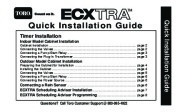 Toro Owners Manual - 1 of 8
Toro Owners Manual - 1 of 8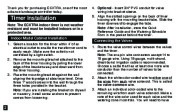 Toro Owners Manual - 2 of 8
Toro Owners Manual - 2 of 8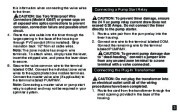 Toro Owners Manual - 3 of 8
Toro Owners Manual - 3 of 8 Toro Owners Manual - 4 of 8
Toro Owners Manual - 4 of 8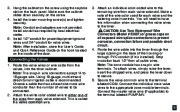 Toro Owners Manual - 5 of 8
Toro Owners Manual - 5 of 8 Toro Owners Manual - 6 of 8
Toro Owners Manual - 6 of 8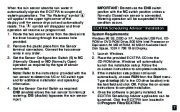 Toro Owners Manual - 7 of 8
Toro Owners Manual - 7 of 8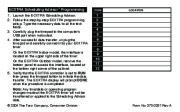 Toro Owners Manual - 8 of 8
Toro Owners Manual - 8 of 8